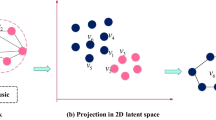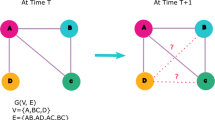Abstract
Link prediction is a popular research area with important applications in a variety of disciplines, including biology, social science, security, and medicine. The fundamental requirement of link prediction is the accurate and effective prediction of new links in networks. While there are many different methods proposed for link prediction, we argue that the practical performance potential of these methods is often unknown because of challenges in the evaluation of link prediction, which impact the reliability and reproducibility of results. We describe these challenges, provide theoretical proofs and empirical examples demonstrating how current methods lead to questionable conclusions, show how the fallacy of these conclusions is illuminated by methods we propose, and develop recommendations for consistent, standard, and applicable evaluation metrics. We also recommend the use of precision-recall threshold curves and associated areas in lieu of receiver operating characteristic curves due to complications that arise from extreme imbalance in the link prediction classification problem.



















Similar content being viewed by others
References
Abu-Mostafa YS, Magdon-Ismail M, Lin HT (2012) Learning from data: a short course. AMLBook
Adamic L (2001) Friends and neighbors on the web. Soc Netw 25(3):211–230
Al-Hasan M, Chaoji V, Salem S, Zaki M (2006) Link prediction using supervised learning. In: Proceedings of SDM’06 workshop on link analysis, counterterrorism and security
Backstrom L, Leskovec J (2011) Supervised random walks: predicting and recommending links in social networks. In: Proceedings of the fourth ACM international conference on Web search and data mining, pp 635–644
Barabási AL, Albert R (1999) Emergence of scaling in random networks. Science 286:509–512
Barabási A-L, Jeong H, Néda Z, Ravasz E, Schubert A, Vicsek T (2002) Evolution of the social network of scientific collaboration. Phys A Stat Mech Appl 311(3–4):590–614
Clauset A, Moore C, Newman MEJ (2008) Hierarchical structure and the prediction of missing links in networks. Nature 453(7191):98–101
Clauset A, Shalizi CR, Newman MEJ (2009) Power-law distributions in empirical data. SIAM Rev 51(4):661–703
Davis D, Lichtenwalter R, Chawla NV (2011) Multi-relational link prediction in heterogeneous information networks. In: Proceedings of the 2011 international conference on advances in social networks analysis and mining, pp 281–288
Davis J, Goadrich M (2006) The relationship between precision-recall and ROC curves. In: Proceedings of the 23rd international conference on machine learning, pp 233–240
Deng H, Han J, Zhao B, Yu Y, Lin CX (2011) Probabilistic topic models with biased propagation on heterogeneous information networks. In: Proceedings of the 17th ACM SIGKDD international conference on knowledge discovery and data mining, pp 1271–1279
Dong Y, Tang J, Wu S, Tian J, Chawla NV, Rao J, Cao H (2012) Link prediction and recommendation across heterogeneous social networks. In: Proceedings of the 2012 international conference on data mining, pp 181–190
Drummond C, Holte RC (2006) Cost curves: an improved method for visualizing classifier performance. Mach Learn 65(1):95–130
Fawcett T (2004) ROC graphs: notes and practical considerations for researchers. ReCALL 31(HPL-2003-4), pp 1–38
Fletcher RJ, Acevedo MA, Reichert BE, Pias KE, Kitchens WM (2011) Social network models predict movement and connectivity in ecological landscapes. Proc Natl Acad Sci 108(48):19282–19287
Getoor L (2003) Link mining: a new data mining challenge. ACM SIGKDD Explor Newsl 5(1):84–89
Goldberg DS, Roth FP (2003) Assessing experimentally derived interactions in a small world. Proc Natl Acad Sci 100(8):4372–4376
Hand DJ (2009) Measuring classifier performance: a coherent alternative to the area under the ROC curve. Mach Learn 77(1):103–123
Hoeffding W (1963) Probability inequalities for sums of bounded random variables. J Am Stat Assoc 58(301):13–30
Hopcroft J, Lou T, Tang J (2011) Who will follow you back? Reciprocal relationship prediction. In: Proceedings of the 20th ACM international conference on Information and knowledge management, pp 1137–1146
Huang Z, Li X, Chen H (2005) Link prediction approach to collaborative filtering. In: Proceedings of the 5th ACM/IEEE-CS joint in proceedings on digital libraries, pp 7–11
Leroy V, Cambazoglu BB, Bonchi F (2010) Cold start link prediction. In: Proceedings of the 16th ACM SIGKDD international conference on knowledge discovery and data mining, pp 393–402
Leskovec J, Backstrom L, Kumar R, Tomkins A (2008) Microscopic evolution of social networks. In: Proceedings of the 14th ACM SIGKDD international conference on knowledge discovery and data mining, pp 462–470
Leskovec J, Lang K, Dasgupta A, Mahoney M (2009) Community structure in large networks: natural cluster sizes and the absence of large well-defined clusters. Internet Math 6(1):29–123
Leskovec J, Huttenlocher D, Kleinberg J (2010) Predicting positive and negative links in online social networks. In: Proceedings of the 19th international conference on world wide web, pp 641–650
Lichtenwalter RN, Lussier JT, Chawla NV (2010) New perspectives and methods in link prediction. In: Proceedings of the 16th ACM SIGKDD international conference on knowledge discovery and data mining, pp 243–252
Lichtenwalter RN, Chawla NV (2012) Link prediction: fair and effective evaluation. In: IEEE/ACM international conference on social networks analysis and mining, pp 376–383
Liben-Nowell D, Kleinberg J (2003) The link prediction problem for social networks. In: Proceedings of the twelfth international conference on information and knowledge management, pp 556–559
Liben-Nowell D, Kleinberg J (2007) The link-prediction problem for social networks. J Am Soc Inf Sci Technol 58(7):1019–1031
Liu X, He Q, Tian Y, Lee WC, McPherson J, Han J (2012) Event-based social networks: linking the online and offline social worlds. In: Proceedings of the 18th ACM SIGKDD international conference on knowledge discovery and data mining, pp 1032–1040
Lu L, Zhou T (2011) Link prediction in complex networks: a survey. Phys A 390(6):1150–1170
Martinez ND, Hawkins BA, Dawah HA, Feifarek BP (1999) Effects of sampling effort on characterization of food-web structure. Ecology 80:1044–1055
Murata T, Moriyasu S (2007) Link prediction of social networks based on weighted proximity measures. In: Proceedings of the IEEE/WIC/ACM international conference on web intelligence, pp 85–88
Mason SJ, Graham NE (2002) Areas beneath the relative operating characteristics (roc) and relative operating levels (rol) curves: statistical significance and interpretation. Q J R Meteorol Soc 2002:2145–2166
Narayanan A, Shi E, Rubinstein BIP (2011) Link prediction by de-anonymization: how we won the Kaggle social network challenge. Arxiv preprint arXiv:1102.4374
Newman MEJ (2001) Clustering and preferential attachment in growing networks. Phys Rev Lett E 64(2):025102
Newman MEJ (2001) The structure of scientific collaboration networks. Proc Natl Acad Sci 98:404–409
O’Madadhain J, Hutchins J, Smyth P (2005) Prediction and ranking algorithms for event-based network data. ACM SIGKDD Explor Newsl 7(2):23–30
O’Madadhain J, Smyth P, Adamic L (2005) Learning predictive models for link formation. In: International sunbelt social network conference
Papadopoulos F, Kitsak M, Serrano M, Boguna M, Krioukov D (2012) Popularity versus similarity in growing networks. Nature 489(7417):537–540
Raeder T, Hoens TR, Chawla NV (2010) Consequences of variability in classifier performance estimates. In: Proceedings of the 10th IEEE international conference on data mining, pp 421–430
Sarukkai RR (2000) Link prediction and path analysis using Markov Chains. In: Proceedings of the 9th international WWW inproceedings on computer networks: the international journal of computer and telecommunications networking, pp 377–386
Scellato S, Mascolo C, Musolesi M, Latora V (2010) Distance matters: geo-social metrics for online social networks. In: Proceedings of the 3rd conference on online social networks, pp 8–8
Scellato S, Noulas A, Mascolo C (2011) Exploring place features in link prediction on location-based social networks. In: Proceedings of the 17th ACM SIGKDD international conference on knowledge discovery and data mining, pp 1046–1054
Scripps J, Tan PN, Chen F, Esfahanian AH (2008) A matrix alignment approach for link prediction. In: Proceedings of the 19th international conference on pattern recognition, pp 1–4
Stumpf MPH, Wiuf C, May RM (2005) Subnets of scale-free networks are not scale-free: sampling properties of networks. Proc Natl Acad Sci 102(12):4221–4224
Sprinzak E, Sattath S, Margalit H (2003) How reliable are experimental protein–protein interaction data? J Mol Biol 327(5):919–923
Sun Y, Han J, Aggarwal CC, Chawla NV (2012) When will it happen? Relationship prediction in heterogeneous information networks. In: Proceedings of the fifth ACM international conference on web search and data mining, pp 663–672
Szilágyi A, Grimm V, Arakaki AK, Skolnick J (2005) Prediction of physical protein–protein interactions. Phys Biol 2(2):S1–16
Taskar B, Wong MF, Abbeel P, Koller D (2003) Link prediction in relational data. In: Proceedings of the conference on neural information processing systems
Viswanath B, Mislove A, Cha M, Gummadi KP (2009) On the evolution of user interaction in facebook. In: Proceeding of the 2nd ACM SIGCOMM workshop on social networks, pp 37–42
Wang C, Satuluri V, Parthasarathy S (2007) Local probabilistic models for link prediction. In: Proceedings of the IEEE international conference on data mining, pp 322–331
Wang D, Pedreschi D, Song C, Giannotti F, Barabasi AL (2011) Human mobility, social ties, and link prediction. In: Proceedings of the 17th ACM SIGKDD international conference on knowledge discovery and data mining, pp 1100–1108
Wittie MP, Pejovic V, Deek L, Almeroth KC, Zhao BY (2010) Exploiting locality of interest in online social networks. In: Co-NEXT ’10 proceedings of the 6th international conference
Yang Y, Chawla NV, Sun Y, Han J (2012) Predicting links in multi-relational and heterogeneous networks. In: Proceedings of the 12th IEEE international conference on data mining, pp 755–764
Yin Z, Gupta M, Weninger T, Han J (2010) A unified framework for link recommendation using random walks. In: Proceedings of the 2010 international conference on advances in social networks analysis and mining, pp 152–159
Acknowledgments
Research was sponsored in part by the Army Research Laboratory (ARL) and was accomplished under Cooperative Agreement Number W911NF-09-2-0053, and in part from grant #FA9550-12-1-0405 from the U.S. Air Force Office of Scientific Research (AFOSR) and the Defense Advanced Research Projects Agency (DARPA). The views and conclusions contained in this document are those of the authors and should not be interpreted as representing the official policies, either expressed or implied, of the ARL, AFOSR, DARPA or the U.S. Government. The U.S. Government is authorized to reproduce and distribute reprints for Government purposes notwithstanding any copyright notation hereon.
Author information
Authors and Affiliations
Corresponding author
Rights and permissions
About this article
Cite this article
Yang, Y., Lichtenwalter, R.N. & Chawla, N.V. Evaluating link prediction methods. Knowl Inf Syst 45, 751–782 (2015). https://doi.org/10.1007/s10115-014-0789-0
Received:
Revised:
Accepted:
Published:
Issue Date:
DOI: https://doi.org/10.1007/s10115-014-0789-0




